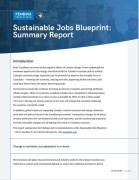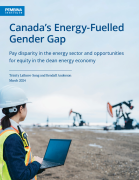Canada has 26 years remaining to achieve net-zero by 2050. The focus of energy experts and government officials to date has been on the technical solutions needed to achieve deep emissions reductions. What is becoming increasingly clear is that a shift of this magnitude cannot happen without the participation of the workers and communities that drive Canada’s economic engine and who will drive its decarbonization efforts. Engaging Canadian workers and communities in the transition to net-zero requires a broad, systems-focused, and wholistic approach.
Reducing emissions without a plan for workers leaves workers and industries with unanswered questions. The Sustainable Jobs Blueprint series co-developed by the Canadian Labour Congress (CLC) and the Pembina Institute aims to offer a pathway to ensure industrial change and decarbonization is informed by social dialogue focused on creating new, good jobs, ensuring workers have a clear path forward.
 In our first report, A Sustainable Jobs Blueprint - Part I: Governance recommendations to support Canada’s clean energy workforce and economy, we examined the shift net-zero based on current global trends. The first report underscored the importance of sound sustainable jobs planning; a robust governance approach with internal structures and accountability mechanisms; and inclusive decision-making that brings workers to the table.
In our first report, A Sustainable Jobs Blueprint - Part I: Governance recommendations to support Canada’s clean energy workforce and economy, we examined the shift net-zero based on current global trends. The first report underscored the importance of sound sustainable jobs planning; a robust governance approach with internal structures and accountability mechanisms; and inclusive decision-making that brings workers to the table.
This second report offers advice on the tactics the federal government can use as it makes investments and develops programs, with the goal of better and more fair outcomes for present and future workers as well as communities. We recommend the federal government take steps to advance the following seven worker- and economy-focused actions, discussed in greater detail in the report.
Advice to Government
The recommendations and actions to consider outlined in Part II of the Sustainable Jobs Blueprint together create a mutually reinforcing sustainable jobs policy approach that puts in place foundational actions to support workers and help optimize the economic outcomes of the shift to net-zero.
Worker-focused recommendations
Invest in skills and training capacity to give workers the tools to succeed: Includes aligning the federal training ecosystem with a net-zero future, bolstering training capacity of non-profit training institutions, transferring funding to provinces and territories to support skills and education programming, incentivizing on-the job training, guiding youth toward sustainable jobs opportunities, supporting newcomers to participate in the workforce and help fill shortages, and implementing Sustainable Jobs Training Centre to support sustainable jobs workforce development needs.
Provide income security and programs that help workers find new jobs or retire early: Includes providing incomes support for workers while retraining, creating flexible work sharing options for workers in declining industries, centralizing the point of access for workers who need to be connected to resources, protecting workers’ pensions, helping workers bridge to retirement, and helping workers move.
Enable a framework to uphold good job standards in the clean economy: Includes reviewing programs and policies in support of unions and worker organizing, including updating the labour code.
Engage with workers about their futures: Includes awareness and dialogue campaigns to inform and engage with workers about the energy transition.
Economy-focused recommendations
Invest in regions to build resilience in a net-zero economy: Includes advancing regional industrial policy priorities, providing capacity and economic diversification support to affected communities, and making it easier for Indigenous people to participate in a clean energy economy.
Develop a net-zero industrial policy that creates conditions for thriving industries: Includes advancing key regulations, creating regional net-zero industrial policy tables, expanding labour conditions on public funding, exploring ways to promote clean domestic industries, and requiring public infrastructure to create greater community benefits.
Leverage private capital to support sustainable jobs: Includes motivating emissions intensive industries to re-invest in decarbonization and finding ways to leverage private capital to help pay for key transition programs, like retraining and economic diversification.
Together, the advice in this Blueprint report forms a worker-centred transition policy framework that the Government of Canada can use to develop the 2025 Sustainable Jobs Action Plan and that the Sustainable Jobs Secretariat can use to undertake deeper analysis and to coordinate implementation; the Sustainable Jobs Partnership Council can continue to consult on and add to this Blueprint’s list of policy areas.
Labour and Economic Modeling
The Canadian Labour Congress commissioned Navius to assess how the transition to net-zero emissions will impact employment and interprovincial labour force growth in Canada, and the role of proposed labour policy interventions in supporting communities and occupations most at-risk. You can download the technical report from the Navius website.







